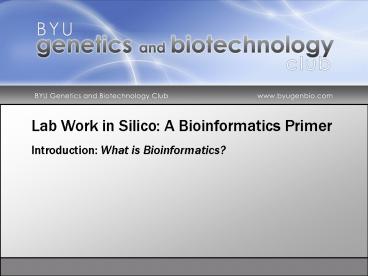Lab Work in Silico: A Bioinformatics Primer - PowerPoint PPT Presentation
1 / 13
Title:
Lab Work in Silico: A Bioinformatics Primer
Description:
'First, the phenomenal rate of biological data being produced provides challenges: ... projects, for example, is not to corroborate or refute a hypothesis, but to ... – PowerPoint PPT presentation
Number of Views:63
Avg rating:3.0/5.0
Title: Lab Work in Silico: A Bioinformatics Primer
1
Lab Work in Silico A Bioinformatics
Primer Introduction What is Bioinformatics?
2
From Bioinformatics - a definition By Michael
Nilges and Jens P. Linge The relationship
between computer science and biology is a natural
one for several reasons. First, the phenomenal
rate of biological data being produced provides
challenges massive amounts of data have to be
stored, analysed, and made accessible. Second,
the nature of the data is often such that a
statistical method, and hence computation, is
necessary. This applies in particular to the
information on the building plans of proteins and
of the temporal and spatial organisation of their
expression in the cell encoded by the DNA.
Third, there is a strong analogy between the
DNA sequence and a computer program
1/5
3
From Bioinformatics - a definition By Michael
Nilges and Jens P. Linge The history of
computing in biology goes back to the 1920s when
scientists were already thinking of establishing
biological laws solely from data analysis by
induction. However, only the development of
powerful computers, and the availability of
experimental data that can be readily treated by
computation (for example, DNA or amino acid
sequences and three dimensional structures of
proteins) launched bioinformatics as an
independent field. Today, practical
applications of bioinformatics are readily
available through the world wide web, and are
widely used in biological and medical research.
As the field is rapidly evolving, the very
definition of bioinformatics is still the matter
of some debate.
1/5
4
When did the term originate? From T K Attwood
and D J Parry-Smith's "Introduction to
Bioinformatics", Prentice-Hall 1999 The term
bioinformatics is used to encompass almost all
computer applications in biological sciences, but
was originally coined in the mid-1980s for the
analysis of biological sequence data. Mark S.
Boguski's article in the "Trends Guide to
Bioinformatics" Elsevier, Trends Supplement 1998
The term bioinformatics is a relatively
recent invention, not appearing in the literature
until 1991 and then only in the context of the
emergence of electronic publishing.
1/5
5
Bioinformatics Definition Committee
1/5
6
Bioinformatics Definition Committee The NIH
Biomedical Information Science and Technology
Initiative Consortium agreed on the following
definitions of bioinformatics and computational
biology recognizing that no definition could
completely eliminate overlap with other
activities or preclude variations in
interpretation by different individuals and
organizations. Bioinformatics Research,
development, or application of computational
tools and approaches for expanding the use of
biological, medical, behavioral or health data,
including those to acquire, store, organize,
archive, analyze, or visualize such
data. Computational Biology The development and
application of data-analytical and theoretical
methods, mathematical modeling and computational
simulation techniques to the study of biological,
behavioral, and social systems.
1/5
7
NCBI Bioinformatics Milestones (before 2000)
1/5
8
Nucleic Acids Research November 1977 Sequence
data handling by computer
1/5
9
Nucleic Acids Research November 1977 Sequence
data handling by computer
1/5
10
GIW 2000 The Eleventh Workshop on Genome
Informatics December 18-19, 2000 Yebisu Garden
Place, Tokyo, Japan
1/5
11
Dell and the Center of Excellence in
Bioinformatics at the University at Buffalo
create Linux-based clusters running on Intel
processors and dedicated to cutting-edge research
in bioinformatics According to Dr. Skolnick,
the amount of data to be analyzed would take
approximately 2,000 years to analyze on a single
computer with one processor. By using the
cluster, he expects to complete his initial data
analysis in just six months. The Dell cluster,
capable of performing more than 5 trillion
calculations per second, is an important tool
that allows Dr. Skolnick to further his center's
vision to enable the development of new medical
treatments for cancer, Alzheimer's disease, AIDS,
and other diseases by creating state-of-the-art
algorithms for data acquisition, storage,
management, and transmission.
A 2,000-node HPC cluster comprising
dual-processor DellTM PowerEdgeTM 1650 and
PowerEdge 2650 servers using Intel XeonTM and
Intel Pentium processors and running the Red
Hat Linux operating system a storage area
network (SAN) with a DellEMC FC4700 storage
array and two Dell PowerVaultTM 136T tape
libraries
1/5
12
- Bioinformatics Today
- Sequence analysis
- Genome annotation
- Computational evolutionary biology
- Measuring biodiversity
- Gene expression analysis
- Regulation analysis
- Protein expression analysis
- Analysis of mutations in cancer
- Structure prediction
- Comparative genomics
- Modeling biological systems
- High-throughput image analysis
1/5
13
Bioinformatics - a definition Michael Nilges and
Jens P. Linge Bioinformatics has a large impact
on biological research. Giant research projects
such as the human genome project would be
meaningless without the bioinformatics component.
The goal of sequencing projects, for example, is
not to corroborate or refute a hypothesis, but to
provide raw data for later analysis. Once the raw
data are available, hypotheses may be formulated
and tested in silico. In this manner, computer
experiments may answer biological questions which
cannot be tackled by traditional approaches. This
has led to the founding of dedicated
bioinformatics research groups as well as to a
different work practice in the average bioscience
laboratory where the computer has become an
essential research.
1/5































